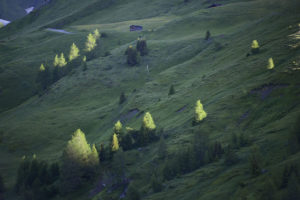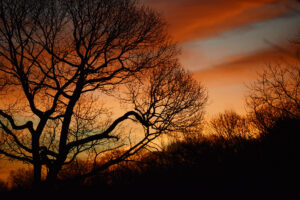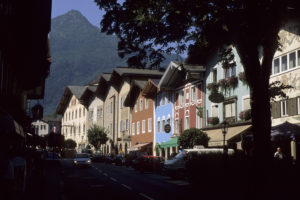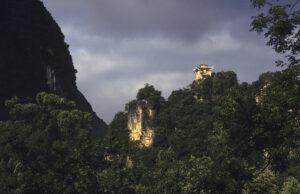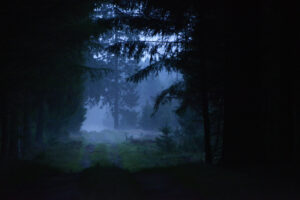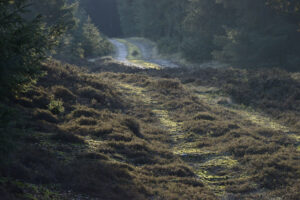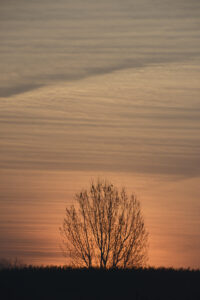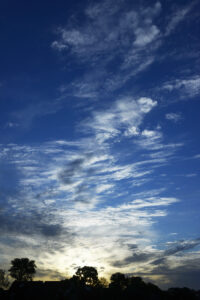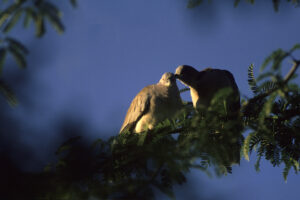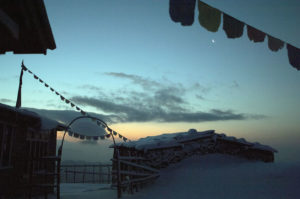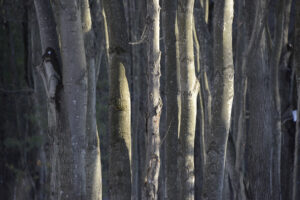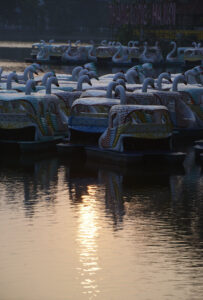Dawn
Morning light on Kalø Hunting Cottage, Rønde, Jutland, Denmark. (Photo copyright © by Kaj Halberg)
Dawn one October morning, Horseshoe Fall, Niagara Falls, St. Lawrence River, New York State. (Photo copyright © by Kaj Halberg)
European larches (Larix decidua), illuminated by morning light, near Kasereck, Grossglockner, Austria. (Photo copyright © by Kaj Halberg)
On a foggy morning in the Nepal Terai, the tropical lowland plains beneath the foothills of the Himalaya, a farmer is hurrying past a growth of bamboo on his way to work in the fields. (Photo copyright © by Kaj Halberg)
Sunrise behind Gunung Abang (2155 m), the third-highest mountain on Bali, Indonesia. (Photo copyright © by Kaj Halberg)
Morning sky above Lake Mono, California. (Photo copyright © by Kaj Halberg)
Grass-clad hills in morning light, Hutiao Xia (‘Tiger Leaping Gorge’), Jinsha River, Yunnan Province, China. (Photo copyright © by Kaj Halberg)
Morning has broken like the first morning,
Blackbird has spoken like the first bird.
Praise for the singing,
Praise for the morning,
Praise for them, springing fresh from the world.
Text written to a traditional Scottish Bunessan hymn by English poet and children’s author Eleanor Farjeon (1881-1965). It first appeared in the second edition of Songs of Praise, 1931. The editor, Percy Dearmer, had asked Farjeon “to make a poem to fit the lovely Scottish tune.”
In 1971, the song was popularized by British singer Steven Demetre Georgiou (born 1948), who performed under the name Cat Stevens. Today, he calls himself Yusuf Islam.
Bunessan hymns are named for the village of Bunessan, situated on the Isle of Mull, Scotland. In this village lived Màiri Dhòmhnallach (1789-1872), in English called Mary Macdonald, who spoke only Gaelic. She wrote her hymn Leanabh an àigh to a traditional melody.
One morning early I went out
On the shore of Lough Leinn.
The leafy trees of summertime
And the warm rays of the sun.
As I wandered through the townlands
And the luscious grassy plains,
Who should I meet but a beautiful maid,
At the dawning of the day.
No cap or cloak this maiden wore,
Her neck and feet were bare,
Down to the grass in ringlets fell
Her glossy golden hair,
A milking pail was in her hand,
She was lovely, young and gay,
Her beauty excelled even Venus,
At the dawning of the day.
On a mossy bank I sat me down
With the maiden by my side,
With gentle words I courted her
And asked her to be my bride.
She said to me, “Go away
And let me go – you rake!
There from the south the light is coming
With the dawning of the day.”
The Dawning of the Day, in Gaelic Fáinne Geal an Lae (literally ‘The bright ring of the day’), composed by Irish harpist Thomas Connellan (c. 1640-1698).
In later versions, the last 4 lines of the poem read thus:
She turned and said, “Please go away,”
Then went on down the way
And the morning light was shining bright
At the dawning of the day.
Quite different from the original version!
The saffron-robed Dawn rose in haste
From the streams of Oceanus,
To bring light to immortals and mortals.
Homer, The Iliad, c. 8th Century B.C.
When the child of morning, rosy-fingered Dawn, appeared.
Homer, The Odyssey, c. 8th Century B.C.
In Greek mythology, the goddess of dawn, Eos, is usually described as having rosy fingers and golden forearms, as she, dressed in a saffron-coloured robe, woven with flowers, opens the Gates of Heaven for the Sun to rise. For the Romans, she was known as Aurora.
“When the child of morning, rosy-fingered Dawn, appeared.” – Orange clouds at dawn, Oyster Bay, Long Island, New York. (Photo copyright © by Kaj Halberg)
To me, the reason for the widespread worship of the Sun in many ancient cultures is obvious. Each new dawn was considered a miracle, as the Sun rose and spread its warm rays for the benefit of plants, animals, and people.
The pictures on this page show various aspects of dawn at locations around the world.
Austria
Morning sun illuminates a house row in the town of Golling, Salzburgerland. (Photo copyright © by Kaj Halberg)
China
Early in the morning, sunshine is beginning to penetrate fog near the town of Weining, Guizhou Province. (Photo copyright © by Kaj Halberg)
Daoism is the prevalent religion in parts of China. This colourful religion is described on the page Religion: Daoism in Taiwan. This picture shows morning light on a Daoist pagoda, which has been built atop one of the peaks in a limestone area near Yangshuo, Guangxi Zhuang. (Photo copyright © by Kaj Halberg)
Beijing Airport at dawn. (Photo copyright © by Kaj Halberg)
Denmark
Sunrise behind dark clouds, Horsens Fjord. (Photo copyright © by Kaj Halberg)
The following 5 pictures show morning atmosphere in Store Hjøllund Plantation, central Jutland.
Forest roads at dawn. (Photos copyright © by Kaj Halberg)
Morning fog blurs the outline of planted Swedish whitebeams (Sorbus intermedia). (Photo copyright © by Kaj Halberg)
Heather (Calluna vulgaris) on a forest road. (Photo copyright © by Kaj Halberg)
Morning light on Norway spruces (Picea abies). (Photo copyright © by Kaj Halberg)
The common ash (Fraxinus excelsior), of the olive family (Oleaceae), is a native of Europe, eastwards to the Caucasus and the Alborz Mountains in northern Iran. It has also become naturalized a few places in New Zealand, the United States, and Canada.
In later years, populations of this species have been much reduced by ash dieback, a disease caused by a fungus, Hymenoscyphus fraxineus, previously called Chalara fraxinea. Most trees that contract this disease die after a few years. However, research has shown that some trees may have resistance to it.
The day is dawning behind an old ash, displaying an abundance of fruits, Funen. (Photo copyright © by Kaj Halberg)
Clouds and condensed exhaust from a jet plane are reddened by the rising sun, Jutland. (Photo copyright © by Kaj Halberg)
The mallard (Anas platyrhynchos) is very widely distributed across subarctic, temperate, and subtropical areas of North America, Eurasia, and North Africa, southwards to Mexico, Morocco, Egypt, Pakistan, and China, and it has also been introduced to many other places as a hunting object, including South America, New Zealand, Australia, and South Africa.
The drake is a gorgeous bird in breeding plumage, with grey sides, purple breast, and glossy-green head, with a blue shine from certain angles. The female is a uniform speckled brown. Pictures, depicting male and female, may be seen on the page Animals – Animals as servants of Man: Poultry.
Pond at dawn with mallards, Funen. The pale birds to the right are domestic geese. (Photo copyright © by Kaj Halberg)
The sycamore maple (Acer pseudoplatanus) is native to Central Europe. It was introduced to Britain around 1500, and has also become naturalized in other parts of Europe, and in Australia, New Zealand, and North America. In many places, it is regarded as an invasive, easily spreading by its winged seeds, which are produced in the tens of thousands on a single large tree.
An example of the effective spreading of this species is seen on the island of Vorsø, a nature reserve in Horsens Fjord, Denmark. On this island, former fields were abandoned in two steps, in 1928 and in 1978. In both cases, thousands of sycamore maple seeds, stemming from a few trees in plantations at the edge of the fields, were spread by the wind. The succession growth of these maple forests is described in detail on the page Nature Reserve Vorsø: Expanding wilderness.
Avenue of sycamore maples on an early winter morning, Jutland. (Photo copyright © by Kaj Halberg)
Divided into about 16 subspecies, the common hogweed (Heracleum sphondylium), or cow-parsnip, is distributed throughout Europe, eastwards to western Siberia, and also in Morocco, Turkey, and the Caucasus.
The hollow stem, to about 1.2 m tall, is bristly-hairy, branched, with bag-like bracts at each node. The fruit is characteristic, strongly compressed and ribbed, the lateral ribs with a broad wing. Inside the fruit are club-shaped resin canals, clearly visible against the light.
The generic name was applied in 1753 by Swedish botanist Carl Linnaeus (1707-1778), alluding to the immensely strong Ancient Greek mythological hero Herakles (in Latin Hercules), undoubtedly referring to the profuse growth of many species in the genus. The specific name was derived from Ancient Greek spondylos (‘vertebrate’), alluding to the segmented stem.
The common name hogweed is variously interpreted, either referring to pigs being fond of eating common hogweed (below), or as a derogatory term, a plant only fit for pigs. Cow-parsnip, used from about 1548, presumably alludes to the plant being eaten by cattle.
Fruiting common hogweed at dawn, Funen. (Photo copyright © by Kaj Halberg)
Pines, blurred by morning mist, Vrads, Jutland. (Photo copyright © by Kaj Halberg)
Sunrise and clouds, Funen. (Photos copyright © by Kaj Halberg)
The European silver fir (Abies alba) is native to montane areas in Europe, from northern France and southern Germany southwards to the Pyrenees and northern Greece, eastwards to the Carpathians and Bulgaria, occurring at elevations up to 1,700 m. It is commonly grown elsewhere, especially northern Europe and eastern North America. It is a large tree, growing to 50 m tall and with a trunk diameter up to 1.5 m, occasionally to 60 m tall and 3.8 m across.
Crescent moon behind European silver firs, eastern Jutland. (Photo copyright © by Kaj Halberg)
Silver birches (Betula pendula) in morning mist, Funen. This species is described on the page Plants: Plants in folklore and poetry. (Photo copyright © by Kaj Halberg)
Morning mist over a moorland, Vrads Sande, Jutland. (Photo copyright © by Kaj Halberg)
Poplars (Populus), also called aspen or cottonwood, of the willow family (Salicaceae), are a genus of anywhere between 25 and 35 species of trees, some of which are indeed majestic, growing to 50 m tall, and with a trunk diameter up to 2.5 m. Poplars are deciduous, and several species display brilliant yellow foliage in the autumn, examples of which may be seen on the page In praise of the colour yellow.
Poplars are native to the major part of the Northern Hemisphere, from subarctic areas southwards to Mexico, North Africa, Iran, the Himalaya, and China.
Pruned Canadian poplars (Populus x canadensis) in morning light, Lyø, south of Funen. In the lower picture, a ruined Dutch-type windmill is seen in the background. (Photos copyright © by Kaj Halberg)
Ethiopia
The doum palm (Hyphaene thebaica) differs from most other palms in that the trunk is branched, with a fan of leaves at the end of each branch. This species is distributed across the African Sahel zone, and in East Africa, from northern Tanzania northwards to Egypt, and also in Israel, Jordan, and the Arabian Peninsula.
Doum palms at dawn, Fuloha Oasis. (Photo copyright © by Kaj Halberg)
France
Morning light through trees, near Ploubezre, Lannion, Brittany. (Photo copyright © by Kaj Halberg)
Holland
Clouds at dawn, Avenhorn, near Enkhuizen. (Photo copyright © by Kaj Halberg)
India
Hindu Brahmin, greeting the sun at dawn on the shore of the sacred Ganges River, Varanasi, Uttar Pradesh. This river, and other aspects of Hinduism, are described on the page Religion: Hinduism. (Photo copyright © by Kaj Halberg)
At dawn, this heavily loaded boat carries passengers across the Ganges River, Varanasi. (Photo copyright © by Kaj Halberg)
The coconut palm (Cocos nucifera) is a very important plant in southern India. Oil and copra (dried coconuts) are utilized in cooking and for lamps, whereas the leaves are woven into mats, used as walls and roofs in houses. The fibres surrounding the nut are woven into rope and mats, and the nutshells are burned to make charcoal. Wood from the trunk is utilized as timber or firewood.
Swaying coconut palms at dawn, Colva Beach, Goa. (Photo copyright © by Kaj Halberg)
Morning traffic, Varanasi, Uttar Pradesh. (Photo copyright © by Kaj Halberg)
Morning light through trees, Keoladeo National Park, Rajasthan. (Photos copyright © by Kaj Halberg)
Indonesia
Clouds at dawn, Kintamani, Bali. (Photos copyright © by Kaj Halberg)
Women at dawn, waiting to sell their vegetables, Kintamani, Bali. The volcanoes in the background are Gunung Abang (2155 m, left) and Gunung Agung (3031 m). The latter is the highest mountain in Bali. (Photo copyright © by Kaj Halberg)
Italy
Morning light on mountains around Passo Falzarego (2105 m), Dolomites. (Photos copyright © by Kaj Halberg)
Kenya
The yellow-necked spurfowl (Pternistis leucoscepus) and the red-necked spurfowl (P. afer) are francolins, the yellow-necked found in north-central Africa, from Eritrea southwards through Ethiopia, Somalia, and Kenya to northern Tanzania, westwards to the eastern parts of South Sudan and Uganda, and the red-necked further south, in a broad belt from Congo, southern Zaire, Angola, and extreme northern Namibia eastwards to Uganda and southern Kenya, and thence southwards to eastern South Africa. The two species meet Uganda, western Kenya, and north-western Tanzania.
They are very similar, the common names referring to the bright yellow/red patch of naked skin on the throat, and to the spurs on the back of the legs of the male. They both have naked red skin around the eyes.
Yellow-necked spurfowl, calling at dawn, Meru National Park. A picture, depicting both species, is seen below under Tanzania. (Photo copyright © by Kaj Halberg)
The mourning collared dove (Streptopelia decipiens) is a widespread and common resident in sub-Saharan Africa. Divided into 4 subspecies, it occurs from Mauritania, Senegal, Gambia, and Nigeria eastwards to Ethiopia and Somalia, and thence southwards to eastern Zaire, Uganda, and northern Kenya. Despite its name, it is not closely related to the North American mourning dove (Zenaida macroura).
Illuminated by the morning sun, a mourning collared dove is preening its mate, Lake Baringo. (Photo copyright © by Kaj Halberg)
Nepal
The day is dawning, following an ice-cold night, near Tharepati, Langtang National Park. (Photo copyright © by Kaj Halberg)
Sunrise behind the peak of Annapurna II (7939 m), central Nepal. (Photo copyright © by Kaj Halberg)
Pakistan
Traffic at dawn, Bahawalpur, Sind. (Photo copyright © by Kaj Halberg)
South Africa
Morning light on rocks, Augrabies National Park. (Photo copyright © by Kaj Halberg)
Spain
Morning sun illuminates turquoise mineral deposits, Los Azulejos de Veneguera, Gran Canaria. (Photo copyright © by Kaj Halberg)
Sri Lanka
A snow-white stupa is dimmed by morning fog, near Haputale. Stupas and other aspects of Buddhism are described on the page Religion: Buddhism. (Photo copyright © by Kaj Halberg)
Sweden
The Eurasian crane (Grus grus) is the most widely distributed crane species in the world, found from England, eastwards across the entire Siberian taiga to northern Mongolia and China, with small isolated populations in southern Europe, Turkey, the Caucasus, and Tibet.
With a total population of nearly 700,000, the Eurasian crane is one of the most numerous crane species, only surpassed by the sandhill crane (Antigone canadensis). In western Europe, breeding numbers have increased dramatically in several countries, including Sweden with 15,000 to 20,000 pairs, Germany with about 8,000 pairs, and Denmark with about 500 pairs. In 1998, the total number in Europe was estimated at 45,000 pairs, but this number has since increased significantly.
Pictures, depicting several crane species may be seen in the gallery at Animals: Cranes, and the sandhill crane is described on the page Animals – Birds: Sandhill cranes are a threat to breeding birds.
Feeding Eurasian cranes, Hornborgasjön. This lake is visited by up to 10,000 cranes in March-April, resting here on their way to their breeding grounds. (Photo copyright © by Kaj Halberg)
Taiwan
Early morning light on high-rise buildings in the city of Taichung. (Photos copyright © by Kaj Halberg)
The grey treepie (Dendrocitta formosae), also called Himalayan treepie, is distributed along the foothills of the Himalaya, eastwards through montane areas of northern Indochina and southern China to Taiwan. In Taiwan, however, the nominate subspecies formosae lives almost down to sea level. In most areas, this bird is rather shy, but in Taiwan it has become accustomed to people, showing no fear at all.
Other pictures, depicting this species, may be seen on the pages Animals – Birds: Corvids, and Animals – Birds: Birds in Taiwan.
Illuminated by the morning sunshine, this grey treepie is preening, sitting on a wire, Taichung, Taiwan. (Photos copyright © by Kaj Halberg)
Morning sun, breaking through clouds and mist, Taichung. (Photo copyright © by Kaj Halberg)
The black drongo (Dicrurus macrocercus) is a common resident in tropical and some subtropical areas of Asia, from southern Iran through the Indian Subcontinent to southern China and Taiwan, and thence southwards to Indonesia. It has also been introduced to certain Pacific islands, where it constitutes a threat to native bird species.
This bird lives in open areas, where it catches flying insects from a prominent perch, such as an electric wire or a bare branch. As its name implies, the plumage of this species is jet-black, with very little sheen.
The generic name is derived from Ancient Greek dikros (‘forked’) and oura (‘tail’), referring to the forked tail of birds of this genus. The specific name is also derived from Ancient Greek, from macros (‘long’) and kerkos (‘tail’).
Subspecies harterti of the black drongo is very common in the lowlands of Taiwan, found in open areas, including farmland and city parks. These birds are calling at dawn in the city of Taichung. (Photo copyright © by Kaj Halberg)
The Chinese tallow-tree (Triadica sebifera), formerly called Sapium sebiferum, is a smallish tree, native to China, Taiwan, Korea, Japan, and northern Vietnam.
The generic name is derived from the Latin triadis (‘a group of three’), originally from Ancient Greek trias (‘three’). The name refers to 3-parted flowers.
The specific name means ‘wax-bearing’, referring to the tallow, which coats the seeds. Candles and soap are made from this wax, and in the Far East, the leaves are used in traditional medicine for treating boils. The sap and leaves are reputed to be toxic, and decaying leaves from the plant are toxic to other plants, inhibiting their growth.
Because of the tallow, this tree was introduced into the United States in the 1700s, and in the 1900s, it was widely planted along the Gulf Coast by the U.S. Department of Agriculture, in an attempt to establish a soap-making industry. However, it soon spread beyond control and is today regarded as a serious pest in south-eastern U.S., which expels native plant species.
This trunk of a Chinese tallow-tree is glowing in the morning sun, Central Taiwan Science Park, Taichung. (Photo copyright © by Kaj Halberg)
Daoism is the prevalent religion in Taiwan, described on the page Religion: Daoism in Taiwan. In this picture, morning sun illuminates the Daoist Shouzhen Temple in Alishan. The main gods worshipped here are the emperor Syuantian, the god Fude, and the goddess Jhusheng. (Photo copyright © by Kaj Halberg)
The smallish golden-rain tree (Koelreuteria elegans), also known as flamegold, grows to 17 m tall. It was named for its gorgeous inflorescences of countless small, yellow flowers, which, at a distance, may resemble ‘golden rain’. Pictures, depicting these inflorescences, are shown on the page In praise of the colour yellow.
According to Kew Gardens, this species is divided into 2 subspecies, elegans, which is native to the Fiji Islands, and formosana, which is endemic to Taiwan. It seems strange that it should occur in these two widely separated areas, but nowhere else, so maybe they constitute two species. Or the plant was brought to Fiji by people?
Subspecies formosana is widely planted elsewhere in the tropics and subtropics as a city tree. It has escaped in several places, and is regarded as an invasive plant in eastern Australia and Hawaii.
In autumn, this tree is also attractive, when it displays an abundance of reddish, purplish, or yellowish fruits.
The generic name honours German naturalist Joseph Gottlieb Kölreuter (1733-1806), professor of natural history at Karlsruhe.
Fruits of golden-rain tree, glowing in the morning sun, Central Taiwan Science Park, Taichung. (Photo copyright © by Kaj Halberg)
Tanzania
Sunrise behind a giant baobab (Adansonia digitata), Tarangire National Park. This majestic tree is described on the page Plants: Ancient and huge trees. (Photo copyright © by Kaj Halberg)
Morning fog on a savanna, Tarangire National Park. (Photo copyright © by Kaj Halberg)
Members of the genus Connochaetes are variously called wildebeest or gnu. The generic name is derived from the Greek konnos (‘beard’) and khaite (‘flowing hair’ or ‘mane’), alluding to the long, flowing beard of these animals. The name wildebeest is Afrikaans for ‘wild cow’, whereas gnu is the Khoikhoi name for these antelopes.
Five subspecies of the blue wildebeest (Connochaetes taurinus), also called brindled gnu, are distributed from southern Kenya southwards through eastern Africa to central Zambia, and from southern Angola and Zambia southwards to South Africa and Mozambique. The specific name means ‘bull-like’, derived from the Greek tauros (‘bull’), whereas the prefix blue refers to the bluish sheen of the coat.
The western white-bearded wildebeest, ssp. mearnsi, is found in southern Kenya and northern Tanzania, west of the Rift Valley, westwards to Lake Victoria. This subspecies undertakes a spectacular annual migration, where 2 or 3 million wildebeest migrate from the Serengeti Plains northwards to southern Kenya, and later vice versa.
Morning sun illuminates the beards of these resting wildebeest, Ngorongoro Crater. Plains zebras (Equus quagga ssp. boehmi) are seen in the background. (Photo copyright © by Kaj Halberg)
Another morning picture from the Ngorongoro Crater, with grazing wildebeest, zebras, and two Thomson’s gazelles (Eudorcas thomsonii). The three species of zebra are described on the page Nature: Nature’s patterns. (Photo copyright © by Kaj Halberg)
Morning light on a yellow-necked (Pternistis leucoscepus) and a red-necked spurfowl (P. afer), standing together on a termite mound, Tarangire National Park. This indicates that cross-breeding may occasionally take place between the two species. They are described above under Kenya. (Photo copyright © by Kaj Halberg)
Sunrise and clouds, Kwale Island. (Photo copyright © by Kaj Halberg)
The giraffe (Giraffa camelopardalis) is one of only two living genera of the family Giraffidae, the other being the okapi (Okapia johnstoni) in Zaire.
The tall and seemingly ungainly giraffe was once distributed throughout Africa, except in rainforest. However, it has diminished alarmingly, and today there may be less than 100,000 individuals.
According to the International Union for Conservation of Nature (IUCN), only one species of giraffe exists, divided into nine subspecies, whereas other authorities recognize up to eight separate species.
The name giraffe was derived from the Arabic zarafah, meaning ‘the one that walks fast’. The specific name is from the Greek words kamelos (‘camel’) and pardos (‘leopard’), and the Latin –alis (‘-like’), alluding to its camel-like shape and leopard-like pattern.
At sunrise, head and neck of a Masai giraffe, subspecies tippelskirchi, are silhouetted against Ol Doinyo Lengai, near Lake Natron. This mountain is sacred to the local Masai people. (Photo copyright © by Kaj Halberg)
Tibet
The landscape around the town of Shigatse is very dry and desert-like. The river valleys, however, do receive some moisture from the morning fog, as seen in this picture. My at times rather grotesque adventures in Tibet are described on the page Travel episodes – Tibet 1987: Tibetan summer. (Photo copyright © by Kaj Halberg)
Turkey
Dawn at the marvellous Sultan Ahmed Camii (‘Sultan Ahmed Mosque’), Istanbul, popularly known as ‘The Blue Mosque’. It was constructed between 1609 and 1616, during the rule of Sultan Ahmed I (1590-1617). Other pictures, depicting this gorgeous building, are shown on the pages Religion: Islam, and In praise of the colour blue. (Photos copyright © by Kaj Halberg)
Dawn in a residential area, Sultanahmet, Istanbul. (Photo copyright © by Kaj Halberg)
United States
Misty morning on the Pacific Coast, near Jenner, California. (Photo copyright © by Kaj Halberg)
Forest swamp shortly after dawn, with 4 species of birds: white ibis (Eudocimus albus, curved red bill), great white egret (Ardea alba, green legs), snowy egret (Egretta thula, smaller, white), and tricolored heron (Egretta tricolor, greyish), ACE Basin National Wildlife Refuge, near Bear Island, South Carolina. (Photo copyright © by Kaj Halberg)
Morning light on young tree trunks, Haverhill, Massachusetts. (Photo copyright © by Kaj Halberg)
Eroded sedimentary rocks in morning light, Badlands National Park, South Dakota. (Photo copyright © by Kaj Halberg)
Ocotillo (Fouquieria splendens) is a strange bush, which grows in dry areas of south-western United States and northern Mexico. Most of all, the stems of this species resemble dry sticks, to which barb-wire has been attached. It is able to grow leaves, and discard them again, up to ten times in a year – an adaptation to prevent excessive loss of water through evaporation during dry periods. In spring, it displays an abundance of beautiful, bright red flowers, which are often pollinated by hummingbirds.
Ocotillo at dawn, Anza-Borrego Desert State Park, California. (Photo copyright © by Kaj Halberg)
Mill Neck Creek is a small creek, situated in northern Long Island, New York State. The following 3 pictures depict morning atmosphere in this creek. The mentioned birds are described on the page Animals – Birds: Birds in the United States and Canada.
Boats in morning light. The birds are ring-billed gulls (Larus delawarensis), a larger American herring gull (Larus smithsonianus), and two American black ducks (Anas rubripes). (Photo copyright © by Kaj Halberg)
Great white egrets (Ardea alba) and two smaller snowy egrets (Egretta thula). These birds are described on the page Fishing. (Photo copyright © by Kaj Halberg)
This great white egret is standing on a pontoon with lobster traps. (Photo copyright © by Kaj Halberg)
The cabbage palmetto (Sabal palmetto), also known as blue palmetto, Carolina palmetto, or swamp cabbage, is a palm species, which may reach a height of 20 m. It is native to the south-eastern United States and the northern part of the Caribbean, including Cuba and the Bahamas.
A close relative, Mexican palmetto, is described on the page Evening.
Winter morning sky behind cabbage palmettos, Big Cypress National Preserve, Florida. (Photo copyright © by Kaj Halberg)
Every year, during their spring migration in March and April, huge flocks of sandhill cranes (Antigone canadensis, previously Grus canadensis), roost in the Platte River, Nebraska, for a few weeks before continuing to their breeding grounds in swamps and lakes further north.
The birds spend the night in the river, and shortly after dawn, with an incredible crescendo of trumpeting, flock after flock takes flight, heading for the surrounding maize fields, where they eat waste kernels, left over from the harvest.
Before dawn, the roosting sandhill cranes in the Platte River are like shadows, before the rising sun casts a yellowish light on them. (Photos copyright © by Kaj Halberg)
Vietnam
Morning traffic on the Long Bien Bridge, Hanoi. (Photo copyright © by Kaj Halberg)
Mornings are pleasantly cool in the city of Da Nang, and a lot of people take the opportunity to jog or walk along the beach. (Photo copyright © by Kaj Halberg)
Fountain and sunrise, Lake Truc Bach, Hanoi. (Photo copyright © by Kaj Halberg)
Light from the rising sun is reflected in Lake Truc Bach. Pleasure boats, shaped as swans, are seen in the background. (Photo copyright © by Kaj Halberg)
House in morning light, Hanoi. (Photo copyright © by Kaj Halberg)
Zambia
Almost all eucalyptus species are native to Australia, but numerous species are extensively cultivated elsewhere in tropical and subtropical countries for their timber, which is in great demand, as it is resistant to insect attacks. It is also used to make paper pulp. Some species are cultivated as ornamentals. Oil from the leaves is an ingredient in throat lozenges, called ‘eucalyptus bon-bons’. The oil can also be used against lice, and to remove spots.
Eucalyptus plantations are very harmful to the environment, not only because large tracts of forest have been cut down, but also because of the water-retaining properties of these trees, causing the soil to dry out.
Other information about eucalyptus trees is found on the page Plants: Plants in folklore and poetry.
Sunrise and clouds behind eucalyptus trees on Ncheta Island, one of the largest islands in the Bangweulu Swamps, northern Zambia. The natural growth of trees on this island has since long been felled to provide timber and firewood, and today eucalyptus trees are planted as a substitute. This fascinating wetland and its people are described on the page Countries and places: Bangweulu – where water meets the sky. (Photo copyright © by Kaj Halberg)
(Uploaded February 2020)
(Latest update November 2024)


